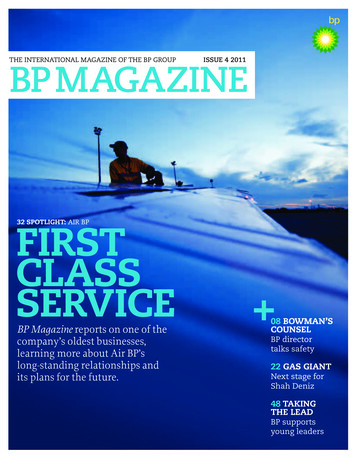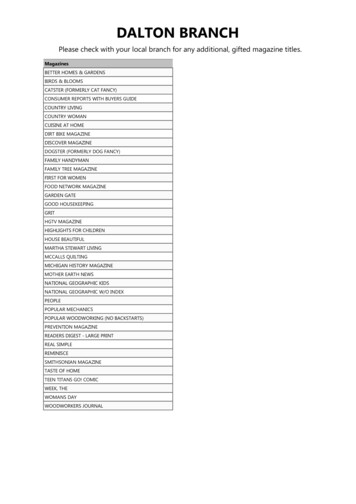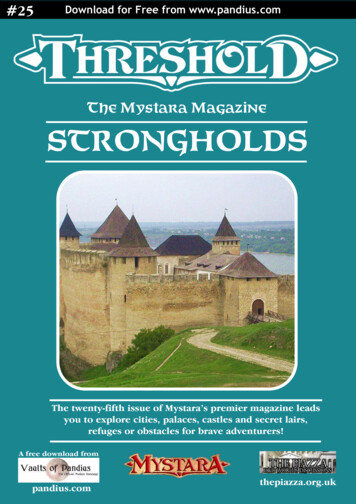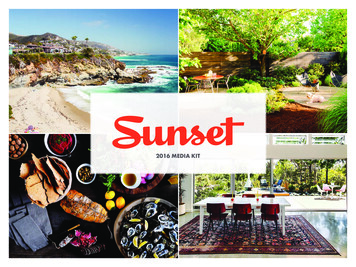
Transcription
THE INTERNATIONAL MAGAZINE OF THE BP GROUPISSUE 4 2011BPMAGAZINE32 SPOTLIGHT: AIR BPFIRSTCLASSSERVICEBP Magazine reports on one of thecompany’s oldest businesses,learning more about Air BP’slong-standing relationships andits plans for the future. 08 BOWMAN’SCOUNSELBP directortalks safety22 GAS GIANTNext stage forShah Deniz48 TAKINGTHE LEADBP supportsyoung leaders
Welcome. The founder of the US nuclear navy,Admiral Hyman G. Rickover, once said, “Youdon’t get what you expect. You get what youinspect.” According to Admiral Frank ‘Skip’Bowman, a former director of the nuclearsubmarine and carrier fleets and now nonexecutive director of BP, it is a principle that BP isnow implementing throughout its businesses.He talks about his 38-year career in the US Navyand its legendary reputation in the world ofsafety and risk management (page 8). He’s notthe only one with a long career behind him. Onpage 32, we find out why Air BP is still a giant inits field, 85 years after it first fuelled a deHavilland Tiger Moth flight from the UK toIndia. Elsewhere in the magazine, we review theactions BP has taken this year to implement itsstrategic priorities (page 15) and we visitAzerbaijan (page 22) to learn more about plansfor the full field development of the giant ShahDeniz gas field. Teamwork features prominentlyin this issue, too, with BP’s head of Production,Bob Fryar, and Olympic athlete Lizzie Armitsteadsharing their thoughts on what it means to workas a group.Lisa Davison Editorcontents / issue 4 2011 Features08 Safe hands Skip Bowman, one of BP’s non-executive directors,talks about his 38 years in the US Navy, and what safety means to him.By David Vigar Photography by Graham Trott15 Turning point A summary of the work BP has done in 2011 onsafety, restoring trust and pursuing growth in shareholder value, aswell as its 10-point plan for the future. Photography by BP Imageshop22 High rise The Baku skyline is changing rapidly, thanks to therevenues being generated by Azerbaijan’s oil and gas industry. BP’s rolein that is about to expand, with plans to develop the full Shah Denizgas field. By Amanda Breen Photography by Mehmet Binay & Stuart ConwayCover story32 Flying high How Air BP is reinforcing its long-standingcustomer relationships as part of a focus on ‘disciplined growth’.By Nick Reed Photography by Aaron Tait & Richard Davies40 Team player The head of BP’s upstream Production division, BobFryar, talks about leading his team and why it’s important for people tospeak their minds. By Lisa Davison Photography by Simon Kreitem, ChrisMoyse, Richard Davies, Marc Morrison, Stuart Conway & Kjetil Alsvik48 Leading the way Meet a few of the young people taking partin the BP-supported Young Leaders programme in the run-up to theLondon 2012 Olympic and Paralympic Games. By Amanda BreenPhotography by Richard Davies54 Banking on BP Having weathered the economic storm of 2008and the financial challenges following the Deepwater Horizonaccident, BP’s Treasury team is in a strong position to face growingglobal uncertainty. By Helen Campbell Illustration by Alex Williamson58 Digital age The team of people dedicated to bringing newtechnologies into the company to help other parts of the business dotheir job more effectively. By Jaclyn Clarabut Photography by HarrisonMcClary, Richard Davies & Marc MorrisonBP MAGAZINEThe international magazine of the BP Group – ISSUE 4 2011BP Magazine is published quarterly for external readers around theworld, as well as past and present BP employees. Its content does notnecessarily reflect official company views.The copyright for photographs and illustrations in BP Magazine is notalways owned by BP. Please contact BP Photographic Services for details.managing editorDavid Vigardavid.vigar@bp.comeditorLisa Davisonlisa.davison@uk.bp.comdistributionCarolyn Copland 44 (0) 20 7496 4340designPhil Steed – Steed Designphil@steeddesign.comwww.steeddesign.comprint managementWilliams Leaimage contributorsBP ImageshopAction ImagesMagic TorchHeart AgencyDebut ArtRex FeaturesCorbisCover image: Air BP’s Michael Rodda replenishes a customer’sBeechcraft King Air during the last light of the day, Brisbane,Australia. Photograph by Aaron Tait BP p.l.c., 201164 Cycle diaries Road and track cyclist Lizzie Armitstead talks aboutpreparing for London 2012, working as a team, and the renaissance inBritish cycling. By Amanda Breen Photography by Action Images70 Social network The Petroleum Society of Great Britain is asold as the UK’s North Sea industry itself and, with a new breed ofyoung geologists getting involved, its future looks very healthy indeed.By Helen Campbell Illustration by Jason Ford Regulars04 For the record A snapshot of BP’s news and statistics fromaround the world.06 Science made simple Extracting hydrocarbons and turningthem into useful products is what BP does every day, but ever wonderhow the oil and gas forms in the first place? By Nic WelshIllustration by Magic Torch20 Viewpoint Inside BP’s Houston monitoring centre.Photography by Rocky Kneten74 Archive A look at some of Air BP’s historical moments over thepast 85 years. Photography by the BP Archive78 Parting shot Building a traditional mudhif at the giantRumaila field. Photography by Ian McGregor
48 Flying highTommy Seagull and threeother young people talkabout their experiences inthe BP-supported YoungLeaders programme.0822
For the recordHighlights from around the globe Winter 2011the quarterin numbers3The number of gasdiscoveries BP has nowmade in the North El Burgoffshore concession inEgypt’s Nile Delta.32,650 sq kmThe total acreage thatBP now has in Angola,following new access tofive more deepwaterexploration andproduction blocks. 1 millionThe prize money for TheQueen Elizabeth Prize forEngineering. BP is one of12 companies backing thenewly-createdinternational award. 1.67 billionThe amount that PlainsMidstream Canada is topay BP for its Canadiannatural gas liquidsbusiness.04 Issue 4 2011 BP MAGAZINEJapanCanadaUSUKNetherlandsEygptBrazilUK: North Sea investmentBP and its partners are todevelop four new oil andgas projects in the UK’s oilindustry that have acombined total investmentof almost 10 billion. Thework will take place overthe next five years and willhelp maintain BP’sproduction from the NorthSea for decades to come. Ata press conference at BP’soffices in Aberdeen,Scotland, the UK primeminister, David Cameron,announced that the UKgovernment has granted BPand its partners – Shell,ConocoPhillips andChevron – approval toproceed with the 4.5 billion Clair Ridgeproject, the second phase ofdevelopment of the giantClair field, west of theShetland Islands. “I amdelighted to give the goahead for this project; thisinvestment is great newsfor Aberdeen and thecountry, and provides amassive boost for jobs andgrowth.”Major investment: BP’s BobDudley (centre left) and theBritish Prime Minister DavidCameron (centre right) at BP’soffices in Aberdeen, Scotland.“I am delighted togive the go-aheadfor this project; thisinvestment is greatnews for Aberdeenand the countryand provides amassive boost forjobs and growth.”David Cameron
USPermit approvalBP has been awardedpermits to resume pluggingand abandonmentactivities in the Gulf ofMexico. It has also obtaineda permit to drill a newappraisal well at theKaskida prospect. Drillingbegan in November.GlobalBoard appointmentBrian Gilvary (above) hasjoined the BP board andbecome the company’s newchief financial officer(CFO). He succeeds ByronGrote, who first took theposition in 2002. Gilvaryhad been BP’s deputy groupCFO and head of financefor almost two years. Grote,meanwhile, will take up anew role as executive vicepresident of corporatebusiness activities. He willalso continue as a memberof the board.USClaims settlementBP has reached agreementwith Cameron InternationalCorporation, the designerand manufacturer of theDeepwater Horizonblowout preventer, to settleall claims between thecompanies related to theDeepwater Horizonaccident and spill. Underthe settlement agreement,Cameron will pay BP 250 million. BP willimmediately apply thepayment to the 20 billiontrust it established to meetindividual, business andgovernment claims, as wellas the cost of the naturalresource damages. See page15 for more on BP’sactivities throughout 2011.USAsset saleBP has agreed to sell itsinterests in the Pompanoand Mica fields in thedeepwater Gulf of Mexicoto Stone Energy Offshore.Under the agreement,Stone Energy will pay BP 204 million in cash. Theagreement includes the saleof BP’s 75%-operatedworking interest (WI) inthe Pompano field andassets, and 50% nonoperated WI in the Micafield, together with a 51%operated WI in MississippiCanyon block 29 andinterests in certain leaseslocated in the vicinity ofthe Pompano field.JapanDream partnershipJapan’s largest airline, AllNippon Airways (ANA), is touse BP’s turbine lubricantsfor the engines andauxiliary power units on itsnew Boeing 787 Dreamlineraircraft. ANA is the world’sfirst commercial customerfor Boeing’s new aircraft,having taken delivery inSeptember 2011 of the firstof 55 planes ordered.BrazilAppraisal successBP has lodged a ‘notificationof discovery’ with theBrazilian National Agencyof Petroleum for the Itaipu2 pre-salt appraisal well,located in the deepwatersection of the Camposbasin. The well, locatedapproximately 130kilometres (80 miles)offshore Brazil, was drilledto a total depth of 4,877metres (16,000 feet) in1,420 metres (4,660 feet)water depth.UKCultural partnershipsBP has renewed andextended its long-standingpartnership with four ofthe UK’s major culturalinstitutions – the BritishMuseum, the NationalPortrait Gallery, the RoyalOpera House, and TateBritain. In total, BP willinvest almost 10 millionin the four partnershipsover the next five years.USWind dealBP Wind Energy has signedwind turbine supply andmaintenance agreementstotalling more than 750 million to continuegrowing its wind portfolioin the US. A total of 350wind turbine units will bedelivered to BP projects.Once operational, theadditional turbines willhave a combined powergeneration of 560megawatts (MW). Some 88turbines will be deliveredto BP’s Mehoopany windfarm located on a 3,640hectare site in WyomingCounty, Pennsylvania.BrazilAir expansionAir BP is expanding itsBrazilian footprint with thepurchase of aviation fuelassets at seven Brazilianairports from Shell BrasilHolding BV and Cosan SAIndústria e Comercio foraround 100 million. Oncompletion, Air BP will bepresent at 18 Brazilianairports which togetheraccount for some 66% ofaviation fuel demand inBrazil. For more on Air BPsee page 32.BP MAGAZINE Issue 4 2011 05
science made simpleReport Nic WelshIllustration Magic TorchIn formationWe use products made of oil and gas every day,but have you ever wondered how thesehydrocarbons were formed in the first place?And what about how and where they are trappedunderground? These are complex questions thathave driven geologists for more than a century, intheir ongoing search for new sources of energy.il and gas are produced fromorganic matter that has beenconcentrated and preservedwithin specific layers ofrock, referred to as ‘sourcerocks’. The organic matter is commonlyknown as kerogen, which has manydifferent forms, depending on theenvironment in which it was deposited.Most oils come from algal and marineplanktonic remains that are deposited inanoxic conditions (see glossary), ensuringtheir preservation. Most gases are derivedfrom terrestrial plant matter that has beendecomposed by bacteria and fungi undersuboxic conditions.In order to generate oil and gas, theorganic matter must then be ‘cooked’. Thisprocess breaks down the kerogen intohydrocarbons. Cooking the materialrequires time and a rise in temperature,which is achieved by burying the sedimentsbelow the ground surface. Typically, thefirst oil is expelled from the source rocks ata temperature of 100ºC (210ºF). As thetemperature rises, the fluids expelled evolveinto progressively lighter oils, then gas.As hydrocarbons are generated, theymigrate out of the source rocks towardsother rock layers. In general, they moveuphill through porous and permeablerocks (reservoirs). In some instances, theywill keep rising until they seep out ontothe ground surface. Indeed, humans haveused oil from these natural seepages forcenturies. Many ancient religions, such asZoroastrianism, incorporate the fires ofnaturally ignited seeps into theirceremonies and beliefs. More recently, BP’sO06 Issue 4 2011 BP MAGAZINEfirst discoveries in Iran were made, in part,following investigations based on naturalseeps in the Zagros Mountains.Often, though, the hydrocarbons hit animpermeable rock layer, known as a ‘seal’,and sometimes the combined geometry ofthe seal and reservoir forms a trap (seeglossary) – some form of upside-down bowlthat prevents the hydrocarbons from risingfurther.So, what does a reservoir look like? It is,in fact, rock with millions of tiny holes – orpores – that fill with oil and gas. Thesepores act as storage spaces. The type of rockin the reservoir will determine the rock’sporosity and a reservoir can look likeanything from a chunk of airport runway –in other words, extremely compacted, withmicroscopic pores – to coarse sandstone,with pores that are visible to the naked eye.This variation is caused by the grainsizes within the rock and by the depth atwhich the reservoir rock is buried. Thedeeper the rock, the higher thetemperature and pressure, causing the rockto compact, and cement to form betweenthe grains.The nature of the reservoir’s pores, or,more precisely, how connected they are –its permeability – is important when itcomes to removing the hydrocarbons fromthe subsurface. The size of the poresdetermines the rock’s ability to store oiland gas, while the permeability determinesthe rate at which oil and gas will flow fromthe rock into a wellbore.A geologist’s job is to create a picture ofwhat is underground in order to makeinformed decisions on where the oil andgas might lie, and where best to drillexploration wells. The trouble is, it can be abit like sitting on the top floor of a high-risebuilding and trying to determine wheresomeone is sitting several floors below. Youmay have an idea of the general floor plan,and you may predict that your target ismore likely to be sitting at a desk thanstanding at the coffee machine, butwithout actually visiting the floor, you’llnever know for sure. Technology hasplayed a vital role in helping geologists, notleast through seismic imaging, whichtransmits soundwaves into the earth andthen uses the echoes to build an image (seeBP Magazine Issue 1 2009 for more onadvanced seismic techniques). Even today,though, with all the seismic techniquesand other technology available, you veryrarely know for sure whether there is oil andgas in the ground until you drill a well. Glossary Seal – an impermeable layer ofmaterial, such as shale, salt, limestoneor anhydrite, that traps oil and gas andstops it from continuing its verticalmigration. Trap – a reservoir/seal geometrythat prevents oil and gas frommigrating to the ground surface. In itsmost basic form, a trap is a concavedownward shape (e.g. a fold or adome). Porosity – a measure of the void(i.e. ‘empty’) spaces in a material. It isexpressed as a fraction of the volumeof voids over the total volume. Permeability – the capability of aporous rock or sediment to permit theflow of fluids through its pore spaces;basically, a measure of the size of theconnections between pores. Anoxic conditions – water withno oxygen content, thus preventingorganic matter from rotting. Thisoften occurs in very restrictedseaways, where there is little watercirculation. The deep Black Sea is onemodern example. Suboxic conditions – water thatis low in oxygen content and,therefore, yields very slow decay rates.
Not to scale.BP MAGAZINE Issue 4 2011 07
inte rvie wInterview David VigarPhotography Graham TrottAN INTERVIEW WITHFRANKBOWMANWith 38 years in the US Navy – the past eight as the man responsiblefor overseeing the safe reactor operations of more than 80 nuclearpowered submarines and 12 nuclear-powered aircraft carriers –Admiral Frank ‘Skip’ Bowman knows a thing or two about keepingpeople safe. He talks to BP Magazine about his experiences and hisnew role on BP’s board, as one of its non-executive directors.08 Issue 4 2011 BP MAGAZINE
BP MAGAZINE Issue 4 2011 09
Interview Frank BowmanWhen Admiral Frank ‘Skip’ Bowman talks to BP’sleaders about safety, they listen very closely – and withgood reason. Bowman spent 38 years in the US Navy,eight of them as director of naval reactors for both thenuclear submarine and carrier fleets, an organisationwith a legendary reputation in the world of safety andrisk management.Since the 1960s, the US Navy’s nuclear subshave travelled 231 million kilometres(144 million miles) and clocked up 6,200‘reactor years’ without an accident, in anextreme, high-hazard environment.Naval submarines are like three-storeybuildings, just nine metres (30 feet) wide,but as long as one or two football pitches.They are powered by nuclear reactors, andsome are armed with nuclear missiles. Eachsub carries more than 100 people deepbelow the ocean’s surface, for months at atime. They are dependent on complextechnology that has to be expertly operatedaround the clock.As director of the US Naval NuclearPropulsion Programme – known asnaval reactors or ‘NR’ – Bowmanwas responsible for overseeing the safereactor operations of more than 80 nuclearpowered submarines and 12 nuclearpowered aircraft carriers for eight years, upto 2004. This was the culmination of anaval career that included serving asdirector of political-military affairs and asthe chief of naval personnel, as well ascommanding a nuclear submarine, the USSCity of Corpus Christi.Given its record, it’s easy to see why theworld’s most hazard-prone industries have“The overarching culture among submariners is one thatinvolves a questioning attitude, a healthy scepticismabout how things are. Nothing is taken for granted.”10 Issue 4 2011 BP MAGAZINEendeavoured to emulate NR’s process andprocedures. NASA, for example, adopted anNR-type programme after the Columbiaspace shuttle accident. Admiral Bowman,in fact, testified before the US Congress onNR’s culture and procedures following thattragedy.More recently, the nuclear navy’s‘SUBSAFE’ system was held up as a rolemodel of process safety in the report of thePresidential Commission into theDeepwater Horizon accident in 2010.Largely through the link with Bowman,BP’s leaders have gained indepthunderstanding of the processes, standardsand attitudes underpinning NR’s multidecade safety record. Bowman served onthe panel that investigated BP’s USrefineries after the Texas City explosion in2005, led by former secretary of state JamesBaker. He then became a member of thecompany’s US advisory council; and inNovember 2010, he joined the main boardas a non-executive director. He has visitedall of BP’s US refineries, as well as twooffshore platforms and the company’sHouston-based learning centre, designed toprovide on-site learning and developmentfor upstream staff. He has also led a sessionat BP’s Operations Academy at theMassachusetts Institute of Technology.Much of the work now being done in BPby Bob Dudley’s team, particularly thesafety and operational risk (S&OR) divisionunder Mark Bly, has strong echoes of NR’sapproach. Three concepts in particularstand out – standardised systems, thirdparty inspection, and developing the skillsand attitudes of individuals.Bowman says: “The submarine nuclearnavy has a set of risk management systems »
BP MAGAZINE Issue 4 2011 11
Interview Frank Bowman“You need to respect even thesmallest amount of risk andevaluate that risk constantly.Risk management is aprocess, not an event.”– for reactors, for submarine integrity, forweapons, for navigation, and so on – andsafety comes from verbatim compliancewith the rigorous set of proc
in this issue, too, with BP’s head of Production, Bob Fryar, and Olympic athlete Lizzie Armitstead sharing their thoughts on what it means to work as a group. Lisa Davison Editor contents / issue 4 2011 . BP’s Bob Dudley (centre left) and the British Prime Minister David Cameron (centre right










